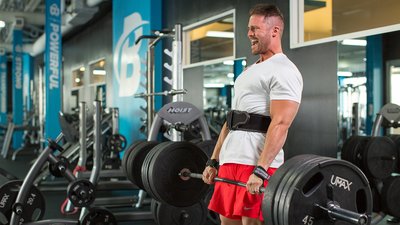When you hit the gym, chances are you're focusing on one thing: adding more weight to the bar. If you want to get stronger and build more muscle, this is a no-brainer. You can always add more reps and sets, but the fast track to big gains is perceived to be piling on the plates.
This said, you won't be able to add more weight each and every time you work out. But, if you follow these tips over time, you should notice a general upward trend in the number of those 45-pound slabs that end up on your bar.
Note: These tips also work if you've hit a strength plateau and can't seem to break through. They'll give you the extra ammo you'll need to destroy your PR.
1. But First…Serve Yourself a Shot of Caffeine
If you're not training with any sort of pre-workout supplement or caffeine, now's the time to start. Caffeine is one of the most highly-used ergogenic aids and can give you a mighty boost in physical energy. It can sharpen your concentration, too.
Research published in the International Journal of Sport Nutrition and Exercise Metabolism found that when subjects supplemented with caffeine prior to a training session, they were able to complete more weight on leg and chest presses—and sustain a higher level of peak power in Wingate tests, which measure peak anaerobic power and capacity.[1]

For best results, start with 200 milligrams of caffeine 30 minutes prior to your workout, then increase the dosage depending on your caffeine sensitivity. Take it easy, though. Large amounts of caffeine can interfere with sleep, and lead to CNS fatigue. More is not necessarily better!
2. Do One Light Set Prior to Your Heavy Set
One mistake some lifters make is going straight for their heavy weight, often after a very light warmup set. That's probably not enough to prep your muscles for the abuse to come.
Instead, start by doing one light set at 40-50 percent of your max load. As you do this light set, make sure you're activating your target muscles. You want every single fiber in these muscles fired up and ready to contract when the intense resistance kicks in. If you move straight to your PR—or work your way up to it gradually—you run the risk of fatiguing your muscles too soon and cutting your workout short.
3. Visualize A Successful Rep
Many great athletes practice "seeing" themselves performing an exercise to perfection. They'll walk themselves through what they need to do, mentally visualizing every step in their process. If visualization works for them, you might want to try it with your next PR set.
Before you start that set—or even before you hit the gym—take a few minutes to visualize yourself using perfect form to complete each lift. The more often you take time to visualize, the more confident you can become. Over time, repeated visualization can even hard-wire your brain for success.

Using visualization doesn't mean you'll suddenly be able to add two more 45-pound plates to your squat. But, if you've been struggling to make that 10-pound jump from your previous PR, this technique could help you get the job done.
4. Get A PR Song
Music is one of the best motivational aids for any kind of physical activity, so why not use it for packing on the plates? The trick is to choose one song that charges you up physically and emotionally. What's the one song that brings out your inner beast, that focuses your mind and elevates your pulse?
Once you find that song, play it only when you do your PR set. Don't listen to it any other time—especially when you're not even at the gym.
Never underestimate the power of good music. Professional athletes don't wear those headphones just to look cool! (Well, most of them don't.)
5. Know Your Pre-workout Nutrition Strategy
Pre-workout nutrition is a must to get optimum results from your program. Ask yourself, though: Are you perfecting your pre-workout nutrition? Or are you following standard protocol and mindlessly eating some protein with some carbs prior to your session?
This basic approach might work if you aren't looking to hit a major PR. But when it's time to really step up to the plate (no pun intended!), you need to dial-in your pre-workout nutrition plan to make sure your body has what it's going to need.

Some people actually feel better when they skip carbs in the hour or two leading up to their workout. That carb hit can actually make them feel slightly sluggish and make it harder for them to generate maximum force.
Experiment with your pre-workout nutrition to see what works best for you. Does taking on a lot of carbs before a workout feel good, or bad? If it slows you down, restructure your day so your breakfast is big on carbs and protein, do the same at lunch, then have a protein-only snack midafternoon before you hit the gym.
As long as you're eating enough high-quality carbs at those earlier meals, you should have all the glucose you need to power your workout.
6. Train the Negatives
Sometimes the best way to gain strength and get past a sticking point is to train through the negative, or eccentric, portion of your reps.
Have a partner help you out with this one. Choose a slightly heavier weight than normal, and have your partner help you during the concentric, or lifting, portion of the movement. With their assistance, you should be able to get the weight up.
At this point, ask them to stop assisting you so you can focus on controlling the weight through the eccentric, lowering portion of the exercise. Most people will find that they're stronger during this portion, and able to complete it without assistance.
Once you've finished the eccentric part of the rep, ask you partner to step in again and help you with the next concentric phase. Train negatives like this enough, and you'll be surprised the next time you try to wrangle some big weight through the concentric.
7. Change Your Scenery
One final tip: Visit a new gym. Akin to an athlete who excels after being traded to a new team, sometimes a change of scenery is all you need to get yourself psyched up and hit that next weight level.
If you've been training at the same gym for years, doing the same workout over and over again, the newness of another gym environment may inspire you to reach new heights.
References
- Yannakoulia, M., Keramopoulos, A., & Matalas, A. L. (2004). Bone mineral density in young active females: the case of dancers. International Journal of Sport Nutrition and Exercise Metabolism, 14(3), 285-297.

